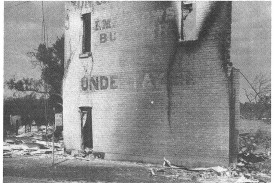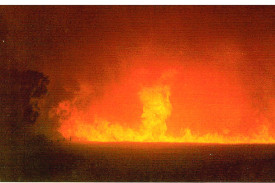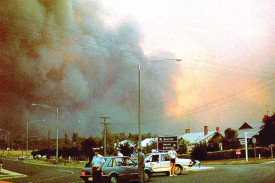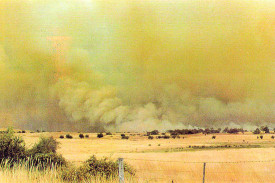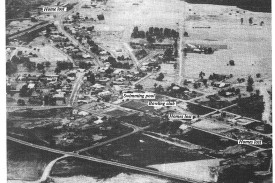General News
17 January, 2025
The 1985 fires from those who were there
Due to extreme conditions, the 1985 fire rapidly developed into the tragedy it became, but the reminders of what happened 40 years ago still remain, including the burnt out shell of the old Phelan homestead outside of Talbot.

When the siren blew at 1.58 pm on January 14, 1985, then Captain of the Maryborough Fire Brigade Ian Duncan couldn’t expect what would come next, nor was it a time he’d ever forget.
“I just thought ‘oh yeah, this will just be one we can mop up in a couple of hours’. By the time we got out to Bung Bong it was obvious that wasn’t going to happen. It was just roaring through the bush and I thought ‘we’re going to be here for the long haul’,” he said.
Due to the extreme conditions, it was out of control within minutes. What would follow burned 50,800 hectares of land, claimed one person’s life, seriously hurt five others, destroyed 101 homes, and burned 500 farms which killed 40,000 livestock.
“I’ve never seen a fire move so fast actually,” Mr Duncan said.
“Say a grass fire will only travel a certain speed, I was flat out in the truck one day and it was virtually passing us ... you’re in the lap of the gods in a way.”
Due to the conditions, fire spotting, where embers start new fires downwind, was a major feature of the fire. According to a report at the time, the extreme conditions and unstable atmosphere meant spot fires were starting up to two kilometres downwind, were developing rapidly, and initiating further spotting and new fronts.
Darryl Wagstaff, current Captain of the Maryborough Fire Brigade but back then a firefighter, remembered knuckling down and focusing on the task at hand despite it being “a very frightening time”.
“On that day I remember driving to Bung Bong to meet the tanker and the vehicle that we were in was blown off the road a number of times because of the strong winds,” he said.
Then Group Officer of Tullaroop, Robert Ipsen, remembers trying to coordinate strike teams to where they were needed from the forward control point near Talbot.
“In the early stages, like any fire, the fire is in control [and] you’re not. You’re playing catch up all the time. Trying to make the best decisions that you can,” he said.
For example, when Mr Ipsen first got to Talbot he was met by a person from Victoria Police pulling up to tell him he’d evacuated Talbot.
“I said ‘where’d you send them because they’ve got nowhere to go ... you get back on your bike and go and tell them to bunker down.’ It was far too late [to evacuate],” he said.
Likewise, Mr Duncan said “we were trying to figure out what the hell we could do with very limited resources”.
Early on when the fire “burst out” of the bush onto cropping land, he initially thought they could get ahead of it and “do something”.
“But after about two minutes we realised no, that’s going to be absolutely futile. We’ve got one truck with 4000 litres of water and no hope of putting anything out much,” he said.
Not only did Mr Duncan have limited resources, his firetruck, a state spare English Bedford with greater firefighting capacity, couldn’t handle the heat and was having troubles all day.
Eventually the truck broke down and they all crowded into one of the brigade’s vans heading back to Maryborough to address the wind change.
“We were up the top end of Majorca Road and our little town pumper was coming up the road, which is pretty useless in a bushfire. So I said to the driver of the van ‘let me out, I want to have a talk to my second in command’. And, as he put his foot on the brake, I got ejected out of the van face first and hit the bitumen,” he said.
“When I woke up I was in the middle of the bitumen trying to work out what was going on with bits of bone sticking out everywhere in my face and a mob of horses coming down the road, which had been let out of a stud. So somehow I had to crawl off the road.”
He broke his top jaw in two places, bottom one in four, smashed his nose, dinted his cheekbone, and cracked his eye sockets. He had to be taken to St Vincent’s Hospital Melbourne the next day and have his jaw wired up for a couple of months.
Despite now living on the coast, some sights of the 1985 fire still stick with him 40 years on.
“One of the horrible things you see is hundreds and hundreds of burnt sheep and cattle all crammed into a corner of a paddock. They’d try to escape the fire and used to get crowded in there and just burnt.”
